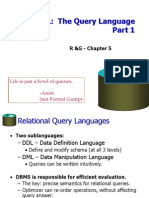0% found this document useful (0 votes)
28 views52 pagesModule-3 SQL.
The document describes how to create and populate tables in an Oracle database. It defines tables for sailors, boats, and reservations and shows how to insert and query data. It also covers SQL query fundamentals including joins, aggregation, patterns matching, and subqueries.
Uploaded by
saloya1764Copyright
© © All Rights Reserved
We take content rights seriously. If you suspect this is your content, claim it here.
Available Formats
Download as PPTX, PDF, TXT or read online on Scribd
0% found this document useful (0 votes)
28 views52 pagesModule-3 SQL.
The document describes how to create and populate tables in an Oracle database. It defines tables for sailors, boats, and reservations and shows how to insert and query data. It also covers SQL query fundamentals including joins, aggregation, patterns matching, and subqueries.
Uploaded by
saloya1764Copyright
© © All Rights Reserved
We take content rights seriously. If you suspect this is your content, claim it here.
Available Formats
Download as PPTX, PDF, TXT or read online on Scribd
/ 52





















































































